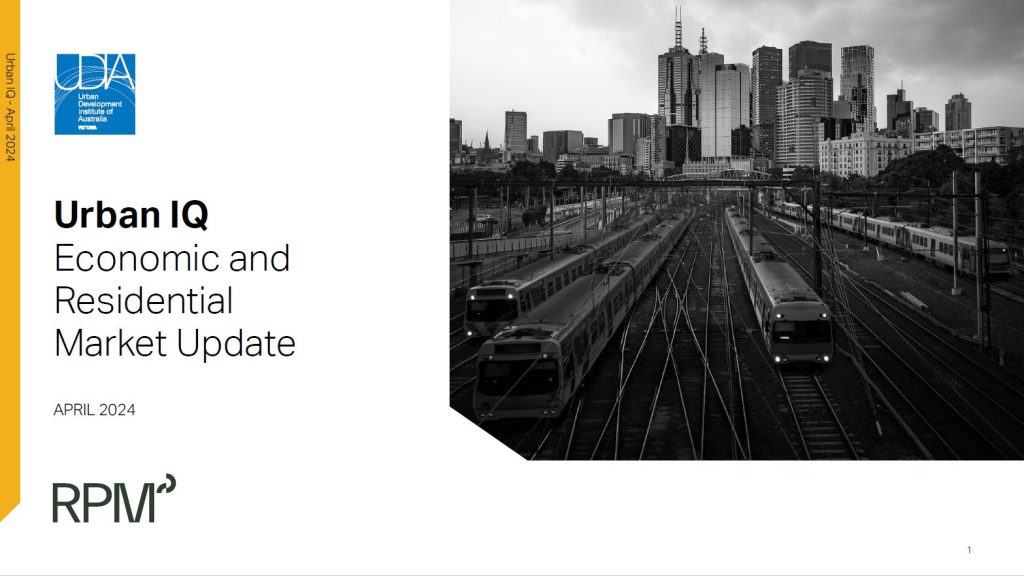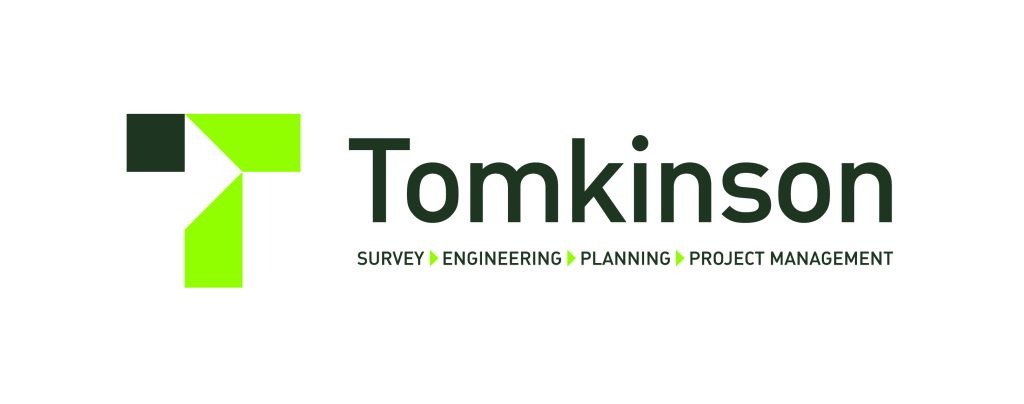UDIA Victoria, in partnership with RPM Group, has released the latest quarterly URBAN IQ research publication.
The research provides data, research and analysis to help our members understand the conditions in which we are operating.
Summary of Key Findings
Economic Overview
- Gross Domestic Product
GDP increased by a moderate 2.06% over 2023, down from solid economic growth of 3.81% in 2022. - Household Savings & Consumption
Household consumption remained steady in Q4 2023, after declining in Q3. Increased mortgage repayments and higher cost of living expenses are forcing consumers to rein in expenditure, particularly on discretionary items. - Interest Rates
4.35% Cash Rate
7.31% Standard Variable Rate for Owner Occupiers
6.80% 3 Year Fixed Rate
With signs of inflation beginning to ease, there is growing likelihood that the RBA’s tightening monetary policy, which saw a total rise of 425 basis points from May 2022, has ended. Despite the RBA easing its tightening bias, it remains wary that inflation is not completely under control, leaving some uncertainty on its next announcement. - CPI and the New Dwelling Index
0.59% Quarterly Inflation.
4.05% Annual Inflation.
1.37% / 1.55% New Dwelling Index.
0.74% / 0.89% CPI Rental Index. - Labour Markets
Employment figures saw a notable uptick in February, with 29,300 persons finding employment. The majority of these were part-time positions with full-time roles comprising only 7%. Despite the increase in employment, the unemployment rate held steady at 3.9%; attributed to the robust population growth expanding the labour force. - Total Employed – 124,200 (12 months to Feb 2024)
- Unemployment Rate – 3.9% (12 months to Feb 2024)
- Wages vs. Inflation
The hourly rate of pay index escalated by 0.9% over Q4, marking a 4.2% annual increase – the highest since Q1 2009. Additionally, real wages in Q4 saw growth for the first time since Q1 2021, as the wage price index outpaced the consumer price index. - Consumer Sentiment
The consumer sentiment index, while still in pessimistic territory at 86 in February, showed improvement – marking its highest reading since June 2022.
This uptick coincided with easing inflation and the growing likelihood of interest rate cuts; contributing to a brighter outlook for family finances in the coming year. As a result, households are gaining confidence in major household item purchases, with the index notably rising over February. This is in contrast with the cautious approach seen in 2023, when consumers tightened discretionary spending. However, there remains some hesitancy regarding property investment, as reflected in the marginal increase in the time to buy a dwelling index. - Business Sentiment
Business conditions improved in February, driven by better trading and profitability conditions.
However, the outlook remains uncertain, with business confidence steady and below its long-term average. Supply side pressures persist for businesses, with challenges in both material and labour availability. These factors pose a risk to inflation outlook, especially as increased costs are transferred to consumers through higher prices. Industries sensitive to interest rates, such as retail and construction, saw weakening conditions, while manufacturing saw a solid increase. - Victorian Population
Population growth in Victoria remained near historically high levels in Q3, continuing to benefit from the surge in overseas migration after international borders reopened. The state recorded a net gain of 49,917 persons in Q3. This marks a long-term high increase for a Q3 period. The state’s total population escalated by 192,723 persons over the 12 months to September. - +7,851 Natural Increase
- +42,105 Net Overseas Migration
- -39 Net Interstate Migration
- Active Estates
New housing developments in greenfield areas have continued to climb, rising by 31 over the twelve-month period to February 2024, to a total of 296 active estates. - Lot Supply
New supply has declined by 12% over the twelve months to February 2024, attributed to significant reduction in lot releases in Geelong. - Lot Sales
Gross lot sales over the three months to February 2024 were 3% higher than the previous corresponding period, with increased sales activity most notably in the South East, Northern, and Ballarat Regions.
1,883 Gross Lot Sales – 3 Months to February 2024 - Share of Sales by Corridor
Sales activity continues to be heavily concentrated in Melbourne growth areas, while the proportion of total lot sales for Geelong and Ballarat converges. - Lot Price Change
An increasing number of growth corridors experienced a quarterly correction in lot prices, after the November interest rate rise placed further downward pressure on prices to combat deteriorating borrowing capacity. - Lot Sizes
With the exception of Geelong, all other growth corridors saw their median lot size shrink over the three months to February 2024, likely in response to challenging affordability.
365sqm = Median Lot Size - Melbourne Residential Market
$909,000 = Median House Price.
-2.2% from last quarter | +1.5% annually
$632,500 = Median Unit Price.
-0.1% from last quarter | +1.7% annually
$386,900 = Median Lot Price.
-0.1% from last quarter | +1.7% annually
Potential buyers became more cautious in Q4 as they grappled with higher interest rates and reduced borrowing capacity – widening the gap between their housing desires and financial realities.
Building Activity
- Victoria Building and Finance Activity
10,030 – First Home Buyer Loans (Q4-23)
$511,000 – Average First Home Buyer Loan Size
17,559 – Non-First Home Buyer Loans (Q4 -23)
$603,000 – Non-First Home Buyer Loans (Q4-23)
26,029 Total New Loan Applications
+13.7% Established Loan Applications
-0.1% Newly Erected Dwelling Applications
+5.3% Construction of a New Dwelling Applications
- Total Approvals Q4 2023
13,778 approvals, or a 0.8% increase over the quarter | -16.3% over the year - Total Commencements
54,550 over FY22/23 which represents a decrease of 18.09 % over the year. - Growth Area Affordability
Historically, the common benchmark for identifying housing stress in Australia has been identified as those that allocate at least 30% of disposable household income to finance their mortgage. This ratio has been in place for decades but recently, there is a growing view that the ratio should be closer to 35% to 40% to reflect today’s market. Income ratios in all growth area suburbs have increased, ranging from 38% in Lara and Armstrong Creek to 61% in Burnside.
Outlook
HEADWINDS
- Consumer Confidence
Still characterised as pessimistic, although has started to pick up, in line with improved outlook for inflation and interest rates. - Inflationary Pressures
Although easing, it will likely remain above the target 2% to 3% range over the next 12 months, continuing to impact the standard of living. - Cash Rate
Appears to have peaked with the potential for an increase if necessary. High rates have placed pressure on household consumption and reduced borrowing capacity. - Population Growth
Strong overseas migration is increasing pressure on the occupier market and underpinning rent inflation.
TAILWINDS
- Labor Markets
Wage growth outpaced CPI in Q4, leading to increased purchasing power for households. However, moderating economic growth is resulting in labour market conditions starting to ease. - Melbourne Reputation
Economist Intelligence Unit (EIU) ranks Melbourne the third most liveable city in the world, and the most liveable in Australia. - Compounding Demand
Strong population growth and millennial household formation are increasing demand. High construction and funding costs are underpinning a significant supply gap. - Australian Dream
The great Australian dream of home ownership remains. This is achievable through the supply of a diverse dwelling options.

The Urban IQ Property Market reports are produced for UDIA Victoria by RPM Group.
The reports provide a quarterly update on the Victorian residential market including economic activity, prices, finance, building, sentiment and affordability metrics.













